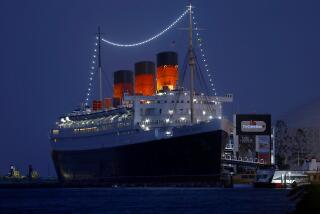Searching for That Offbeat Sunset
- Share via
Although airline acquisitions and mergers during the past several years have grabbed the nation’s headlines, cruise lines too have been consolidating and restructuring with an eye to new marketing angles and fresh destinations for repeat passengers.
One of the latest in the series is Holland America Line’s purchase of a 50% interest in Windstar Sail Cruises, a young company that operates 150-passenger, four-masted luxury sailing/cruise ships with automated, computer-operated sails.
What is it that attracts a large company with three traditional, even conservative, 1,200-passenger vessels to a fledgling line with an offbeat product and ships carrying only a tenth as many people?
Filling In a Lull
Spokesman Rich Skinner said that Holland America was looking for a fresh cruise concept to fill in during the lull before its new ships are ready in late 1989 and 1990, and added that Windstar’s small ships are ideally suited for charters and group-travel markets.
Such acquisitions also provide a chance to tap into the hottest new cruise phenomenon--younger, more affluent travelers looking for lively and luxurious “brand-name” vacations on less conventional ships. Lines like these also mean access to new destinations, such as the year-round Tahiti itinerary for Windstar’s new Wind Song, a fresh alternative to Holland America’s regular schedule of Alaska summers and Caribbean and transcanal winters.
The Windstar management organization is expected to remain unchanged under the new financial agreement.
Similar marketing opportunities led Cunard to take over Norwegian American Cruises in 1983 and Sea Goddess Cruises in 1986, Klosters/Norwegian Caribbean Line to acquire Royal Viking Line in 1984 and Ocean Cruise Lines to buy Pearl Cruises of Scandinavia in April of this year.
Respect for Loyalty
In each instance the new owners intend to maintain the status quo, and, except for some changes in registry and union status, will attempt to keep the same atmosphere and style aboard to hold onto the original clientele.
Cruise passengers are a loyal lot. If the initial experience of a shipboard holiday pleases them far beyond their expectations (cruises traditionally earn the highest passenger satisfaction level of any form of travel), they tend to stick with a winner and return again and again to the same ship or cruise line. They are drawn by discounts offered to repeaters and the comfortable familiarity of “going home.”
For the same reasons, however, they are leery of any changes, and if “their” ship has been taken over by another line they go into spells of anxiety, convinced that the new company will “ruin” it.
Bit of Trepidation
Since its debut in 1984, Sea Goddess has been one of our favorite lines; we traveled aboard both Sea Goddess ships during their inaugural seasons and were delighted with the luxury, the absence of structured activities such as bingo and variety shows, the appealing ports of call and the superb food and service on these admittedly ultra-expensive voyages.
So it was with a bit of trepidation that we recently boarded Sea Goddess II in the Mediterranean for our first sailing since Cunard acquired the ship in August, 1986.
We needn’t have worried. The ship is every bit as elegant as it was before, and familiar faces on board include tall, blond and handsome Capt. Pedersen and friendly maitre d’ Jimmy Lochhead.
We did notice the absence of the latter’s deluxe afternoon tea service with custom-blended teas, replaced with a simpler deck version--a buffet table with sandwiches, cakes and an assortment of tea bags.
Sampling Luxury
But Cunard has introduced one advantage that should please every sybarite with Dom Perignon tastes on a Mumm’s Cordon Rouge budget. It’s a “luxury sampler plan” that awards to passengers sailing on the line’s other ships vouchers good for discounts on Sea Goddess travel--20% off when used within 12 months, 10% off if used within 24 months.
The food on board is excellent--perhaps even better--under the direction of a new young Austrian chef, Johannes Salfelner, who shops daily in ports for fresh fish, fruits and vegetables.
Skeptics who feared Cunard would trim the operating budgets of these yachtlike ships should see the nightly hors d’oeuvres in the chic gray-and-silver lounge. An assortment of hot-and-cold tidbits surrounds a blue tin of large-grained, gray Beluga caviar, accompaniments, saucers and help-yourself spoons.
Midday Buffet
But there’s more than top-quality caviar to titillate the palate. A deck-luncheon cold buffet with a selection of hot dishes offered so many luscious choices that we realized at the end of the week that we had never once gone into the dining room at midday. There was a beautiful paella fresh from Barcelona’s marketplace, homemade pasta, grilled fresh fish with beurre blanc or champagne sauce, even juicy hamburgers and hot dogs.
At dinner, passengers enter when they like between 8 p.m. and 10 p.m., sit where they please and order a la carte dishes on or off the menu, or dine alone together by candlelight in their suites. Selected dinner wines, champagnes and spirits are included in the basic fares.
All accommodations are bedroom-sitting room suites with a fully stocked complimentary bar,color TV and VCR, combination safes, king-size beds and bathroom with tub and shower.
The ship’s Mediterranean ports of call are glamorous, and in many cases not familiar enough to be cliches. The charming picture-book village of Collioure near Perpignan, southern France; Portoferraio, Italy; Elba Island, Italy, and Bonifacio, Corsica, are rarely visited by Americans but are featured in several itineraries.
One Missing Link
The only discernible comfort missing under Cunard that Sea Goddess cruises used to provide is shore support, the business of arranging transfers or meeting passengers at the gateway airport, especially important because the most critical aspects of a journey are the beginning and the end.
Still, most Sea Goddess veterans will agree that Cunard combines the tradition of top luxury cruises with the sense of being a guest on a private yacht, surely the best of both worlds.
Next fall and winter Sea Goddess II will return to South America for eight- and 10-day sailings from Rio de Janeiro and Buenos Aires, including a Carnival in Rio itinerary for Feb. 7.
Prices for the eight-day sailings are $5,000, for the 10-day cruises $6,300 per person, double occupancy, in November and December-- increasing to $5,200 and $6,600 in January, February and March.
Prices include round-trip air fare from major gateways.
Sea Goddess I, meanwhile, has returned to North American waters after a long season in the Pacific and Orient. When we went aboard in Alaska in early July, the hull needed fresh paint. However, the interior had just been recarpeted and looked brand-new.
If you want to sample Sea Goddess service, September is bargain time, with per diem prices as low as $300 on a four-day positioning cruise from Vancouver to Los Angeles on Aug. 30, $330 a day for a 20-day transcanal cruise from Los Angeles to St. Thomas, and $400 a day for a 10-day round trip from Los Angeles along the Mexican Riviera.
More to Read
Sign up for The Wild
We’ll help you find the best places to hike, bike and run, as well as the perfect silent spots for meditation and yoga.
You may occasionally receive promotional content from the Los Angeles Times.






